The Beginner's Guide to Buying Vinyl and Record Players (Turntables)
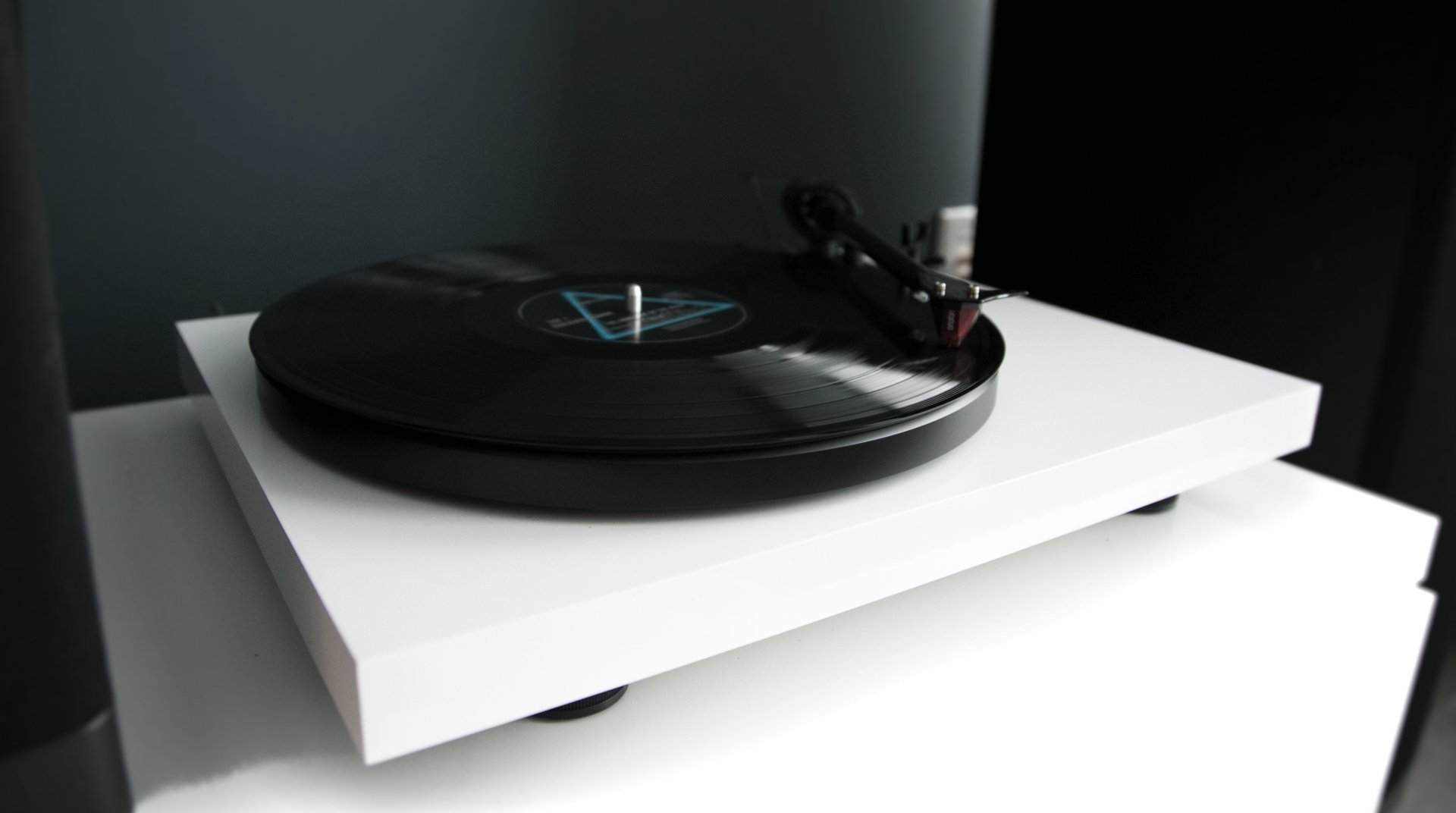
If you’re interested in starting a vinyl collection but have never owned a record player, the process can be very daunting. There is a lot to take consider when listening to vinyl that you don’t have to deal with when using more modern music technologies. The following guide will not only teach you everything you need to know about getting started with vinyl records but also what to look for when purchasing a record player and how to take your setup to the next level.
Why switch to vinyl?
The first thing to know about vinyl is that it is an analog format. You might already be aware of that, but what does that mean? It’s quite simple. Think of sound as a vibration that can be represented by a wave. A song is composed of hundreds of thousands of these tiny waves. If you look at your vinyl records through a microscope, you'll actually see variances in the grooves. As the record spins, the stylus (needle) from your record player reads these grooves and sends these vibrations over to the speakers, which in turn produce the sound you hear.
With digital formats, we rely on a series of tiny dots that are represented by a series of ones and zeros (known as bits) to artificially create these waves. The more bits used (higher bitrate), the more accurately your wave is represented. Remember those old connect-the-dots drawings that you had as a kid? If your picture had more dots, then it appeared more realistic – the same concept applies to bitrate. Once it’s time to output the music, these bits are converted to a signal your speakers can understand (analog vibrations). This is of course an oversimplification of the process as other factors – such as encoding and decoding algorithms, and lossless compression – play a major role in digital music sound fidelity.
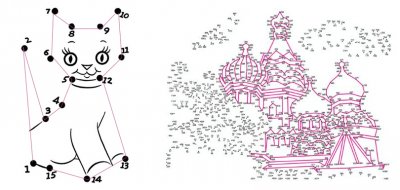
As you can imagine, pure analog is more accurate than digital but when using very high bitrates, the human ear cannot distinguish the difference between the two.
Much of the love for vinyl comes from the sound it produces which feels more intimate and more natural than something that is digital.
When you play a record, you’re experiencing the album the way the artist intended it to be consumed – in a sequential order and without skipping tracks. Let’s be honest, no one gets up and switches to the next song on vinyl.
Vinyl is also beautiful. The cover art is gorgeous on the larger 12-inch album covers. This makes for a great showcase in your home.
What are the downsides of vinyl?
The problem with vinyl and most analog systems is degradation. Over time, your records can get scratched, dulled, or warped which ruins the overall sound quality. Dust and dirt accumulate in the grooves quite easily, which can create crackling sounds. Vinyl pressing is prone to dust accumulation and imperfections, which means that even a brand new record can experience sound issues.
With digital formats, this is less of a problem, especially if you're using non-physical media, such as streaming music. I emphasize non-physical because CDs have a tendency to scratch easily and skip, and since they store so much more information, each nick represents a large amount of lost data.
Another downside is that vinyl is expensive. Record prices can range from $15 to $40 for a standard album. There’s nothing worse than spending $40 on a record and then having it scratched. With non-physical digital media, you can always re-download the song, restore a backup, or stream the music. On the bright side, vinyl is much better at maintaining its value. If you ever want to resell a record, you’ll get most of your money back. Good luck selling a used CD.
Vinyl is also a larger physical media which means that it can take up quite a bit of space in your home as your collection grows. Side note here, always store your records vertically otherwise, they will be prone to warping. When doing so arranging vertically, you'll notice that one of the sides shows both the artist and the album's names in a small font. This should face outwards to make it easier for you to find your record.
Don’t forget, you don’t need to go 100% vinyl or digital, a healthy combination of the two is recommended. Vinyl works best when the source material was recorded in analog, or if you're planning on only listening to the album in the comfort of your home. Digital formats work best when you want to add certain tracks to a playlist, or when you want to listen to them on the go.
Can vinyl records be stereo?
Absolutely. Monaural (mono) is when both speakers output the exact same sound. Stereo on the other hand produces different sounds (channels) for both speakers. With mono, the grooves on the vinyl record are vertical – they can also be horizontal, but we'll focus on vertical. The stylus reads the grooves in an up-and-down fashion. With stereo, the grooves are shaped like a “V.” The stylus bounces back and forth from the left side of the V to the right side. The left side sends information to your left speaker and the right one to the right. You can see this in action in the animation below that was taken using an electron microscope. If you're interested in knowing more, here is the video source.
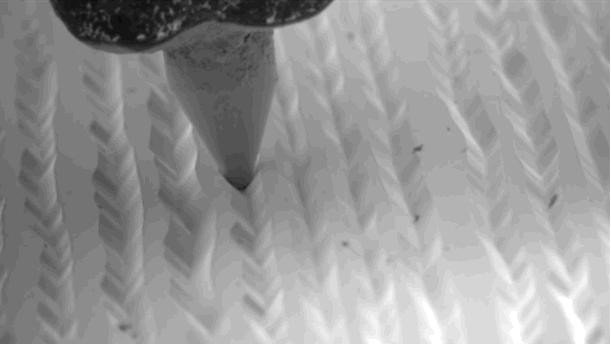
How do I play vinyl records?
By now, you should have guessed that you need a record player, an amplifier (integrated or external), a pair of speakers (or headphones) and your favorite record. We have a detailed guide on how to play a vinyl record which I highly recommend you begin with. Here are the cliff notes.
- Take the record and place it on the turntable platter
- Turn the record player on so that the turntable begins to spin
- Take the tonearm (a.k.a the arm) and place it over the record so that the stylus is over the outer edge of the record but do not down on the tonearm
- Next to the tonearm there is a lever (the cueing level), by pressing the lever down, the stylus will automatically start to drop slowly until it touched the records. Eureka sound!
If don’t hear anything at this point, here are some rookie mistakes:
How do I skip tracks on a vinyl record?
If you look at your record, you’ll notice that there are grooves that are a different hue — these areas mark the beginning of a track. If you want to listen to song number 3, then simply place the stylus over the second area (Since track 1 is the outmost one), then press down on the cueing lever which will do the rest for you.
How do I properly stop a record?
When you’re done listening to a record, proceed in the following order.
- Use the cueing level to raise the arm and move the arm into its reset position
- Press the power button and wait until the turntable comes to a complete stop
- These two first points can be done in either order but if you press stop before raising the tonearm then you will hear a sound akin to batteries dying on a walkman
- Gently remove the record by grabbing it from the outer rim (avoid touching its surface with your greasy hands)
- Slide the record back into it’s case but do not drop it in
- Shut the lid on your record player and put the protector back on the stylus if it has one
What’s the difference between a record player and a turntable?
While many assume that this is a regional naming convention it's actually not. A record player is the actual machine whereas a turntable is the platter that the record spins on. It’s really as simple as that. Most people will call the whole device a turntable. While they may be technically wrong, let’s not bother correcting them since turntable sounds way better anyway and we don't want to be *that* person.
Why is the volume on my record player / turntable so low?
This is a very common issue reported by people who are new to physical media. Earlier in this article, I mentioned that a stylus will read the grooves on the vinyl and transmit that information to the speaker. In that setup, it won’t sound very loud. There’s nothing in the process that is taking those tiny vibrations and making them sound louder or amplifying the sound. To do this, you'll require an amplifier. You have three options here and they’re listed from least desirable to most.
What’s the difference between a belt drive and direct drive turntable?
A direct drive turntable spins using an integrated motor, whereas a belt-driven turntable has a tiny belt that spins the turntable. You need a direct drive turntable if you plan on mixing or DJ-ing. According to audiophiles, belt-driven turntables produce a better sound as the belt helps absorb shocks. I personally can’t tell the difference. With direct drive, you can switch between 33 and 45 RPM playback speed using a button; with belt driven, you need to manually adjust the belt.
What are the benefits to more expensive players?
This question can take thousands of pages to explain but here it is in a nutshell. The higher end you go, the better fidelity you will achieve. This is accomplished by reducing external noises such as other vibrations, using better styluses and cartridges to improve reading, more accurate spinning, heavier platters, less motor noise, better tonearms, and 78 RPM support to name a few.
As with many things in life, when choosing a record player, aim to get whatever is within your budget – but you also get what you pay for. Anything in a suitcase bought at your local hipster store, for example, should be avoided at all costs. Not only will the playback quality suffer, but you will cause some serious damage to your records.
What’s an EP? What’s an LP?
An LP is a Long Play record (think of this as a full album release) whereas an EP is an Extended Play record (think of this as a shorter, 5-6 song album). Yes the names appear to be inverted but if you think of it this way, it will make a bit more sense:
What are RPMs and how many do I need?
You don’t need any RPMs; they’re not something you get, but you’d be amazed at how many times I’ve been asked this question worded in this way. RPM is an acronym for Revolutions Per Minute which is a fancy way of saying “how many times the record makes a full spin in a minute.” Most records are recorded for 33 RPM playback, but higher quality ones are at 45.
Analogy time. Think of a record as toilet paper. Imagine you had two rolls (A and B), each in their own spindle. You start to roll both of them at the same time but you spin roll A twice as fast as roll B. If after 10 seconds you stop, cut the paper and began to write on it, you’d have twice as many sheets at your disposal with roll A. The downside is that as you continue to roll both again, you'll run out of sheets with roll A whereas roll B will last twice as long.
What this means when applied to vinyl is that on a standard 12-inch record, the 45 RPM version can store 35% more sound information in a single minute over a 33 RPM record but that same 45 RPM record can only hold 74% as many minutes of music.
What’s the best turntable for a beginner?
As mentioned earlier, avoid suitcase record players or USB ones unless the latter is a feature you absolutely want. USB is used to let you copy your vinyl to your computer, a feature that you will probably never use unless you have some extremely rare live recording vinyl. Audio Technica has some very nice models for newcomers. My personal favorite for someone on a real tight budget is the Audio Technica AT-LP60 at $100. I would recommend that, if budget permits, you skip directly into the next category however as the increase in price is justifiable.
See the Audio Technica AT-LP60 at $99 on Amazon.
What’s the best record player under $400?
This is where you can start to experiment with some really good quality options. My personal favourite and the turntable I’m currently using at home: the Pro-Ject Carbon Debut. Why? It’s a gorgeous player that includes some features that you will only find in higher end models, such as a carbon fiber tonearm and superb speed control. It’s a very minimalistic and sleek looking record player available in several bright colors (there are even some special edition designs available at a premium). The player is also upgradable, which is fantastic. You can replace the tone arm, the cartridge, and the turntable platter for higher end parts down the road. It does not include a pre-amp, so make sure you pick one up. One thing I do not like about this player is the instructions manual. It was clearly not translated properly and it’s hard to follow the initial setup. I would strongly recommend following a YouTube video for the setup.
See the various Pro-Ject Carbon Debut colors on Amazon ($399)
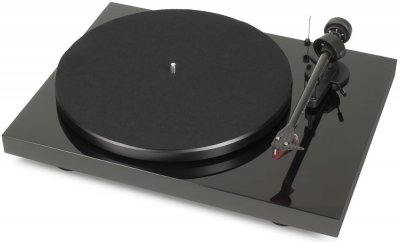
Best Runner up
The second place prize goes to the Audio Technica AT-LP120-USB. Wait, I thought you said not to get a USB turntable? This player is good despite of that feature. Unlike the Pro-Ject Debut Carbon, this one is a direct drive player which means you can DJ with it if you’re so inclined to. It supports 33, 45, and 78 rpm speeds with dedicated buttons, pitch adjustments and best of all, it has an internal pre-amp. It’s also $100 less than the Pro-Ject Debut Carbon (even cheaper when you factor in the pre-amp cost). Why did I chose ProJect over this one? Quality, performance, and looks.
See the Audio Technica AT-LP120-USB on Amazon ($299)
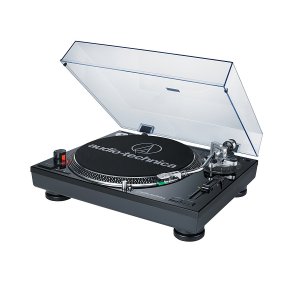
What’s a good amp to use with my record player that won’t break the bank?
The Pro-Ject Phono Box S is a fantastic pre-amp. It will boost your signal and you won't experience any noticeable noise gain. Despite it's tiny size, it can pack a huge punch. There are 4 different gain levels (loudness) but even on the lowest setting it's generating enough juice for my speakers to function at normal volume levels.
Get the Pro-Ject Phono Box S for just $179 on Amazon

Thank you for reading this guide and I hope you have a better understanding of how vinyl works and you know where to begin your musical journey. If you have any questions, please reach out to us at contact+vinyl@upvenue.com. You can always check back for more updates.